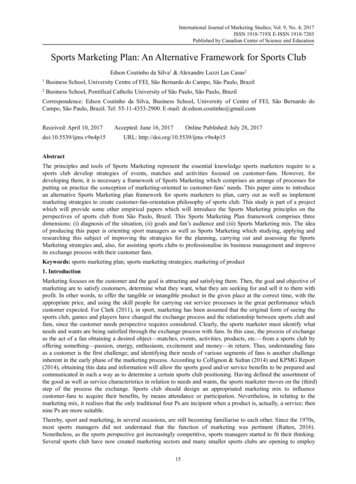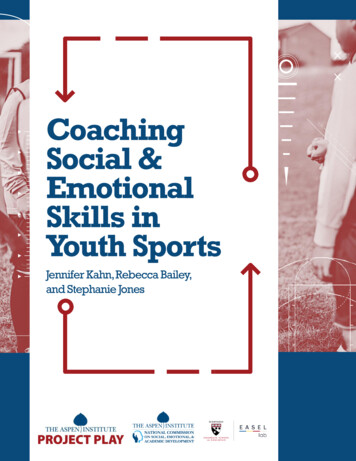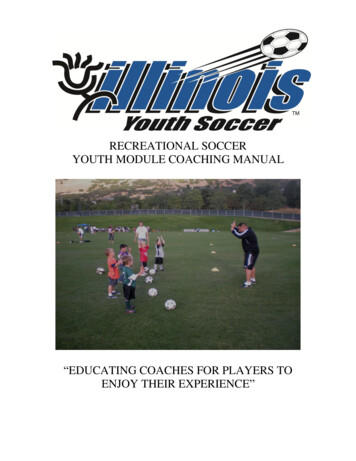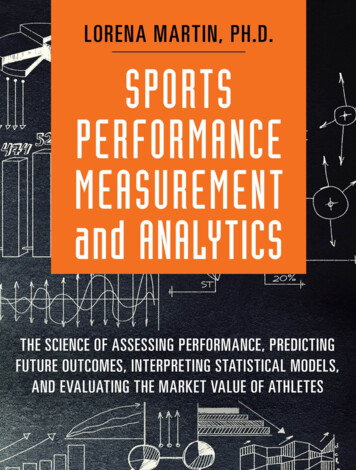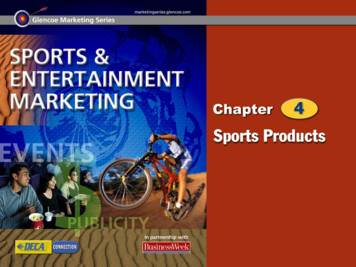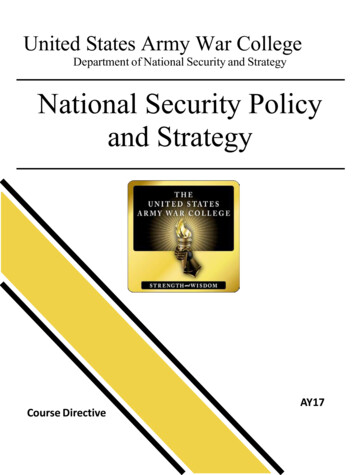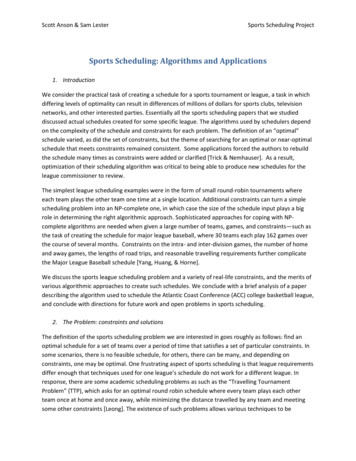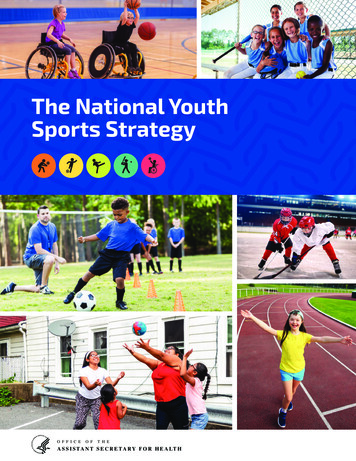
Transcription
The National YouthSports StrategyO F F I C EO FT H EA S S I S T A N T S E C R E T A R Y F O R H E A LT H
Message from the Assistant Secretary for HealthAs the Assistant Secretary for Health, I oversee the U.S. Department of Health and Human Services’(HHS) key public health policy offices and programs, 11 Presidential or Secretarial advisory committees,10 regional health offices across the nation, the Office of the Surgeon General, and the U.S. PublicHealth Service Commissioned Corps. My office is committed to leading America to healthier lives. Weare excited to publish our latest strategy that promises to substantially improve the health, longevity,and quality of life for Americans: the National Youth Sports Strategy.We know from our work developing the Physical Activity Guidelines for Americans, 2nd edition thatyouth need at least 60 minutes of moderate-to-vigorous physical activity each day for good health; yet amajority of youth are not moving enough. Youth who are physically active are healthier, have less bodyfat, and exhibit improved cognition and mental performance. There can be additional benefits gainedwhen playing sports and the opportunity to develop physical literacy and important life skills. Despitethese benefits, only 58 percent of youth ages 6 to 17 participated in sports in 2017, and the numbersare lower for girls, racial and ethnic minorities, youth from households of low socioeconomic status, andyouth with a disability. In addition to these disparities, the cost of participation in sports continues tobe a major barrier for youth and families across the country. Close to 60 percent of parents reportedspending between 250 and 2,500 on sports programming each year. Youth sports is an estimated15 billion-dollar industry, fueled by a pay-to-play model that often focuses on specialization rather thanpositive youth development.In February 2018, President Donald Trump issued Executive Order 13824, titled “President’s Council onSports, Fitness & Nutrition,” which directed the HHS Secretary, Alex M. Azar II, to develop a nationalstrategy on youth sports. Secretary Azar has entrusted the Office of the Assistant Secretary for Health(OASH) with the execution of this important work. The ultimate goal of the National Youth SportsStrategy is to increase youth engagement in communities with below-average sports participation andlimited access to athletic facilities or recreational areas. The Office of Disease Prevention and HealthPromotion, which recently developed and released the second edition of the Physical Activity Guidelinesfor Americans, led this effort on behalf of OASH.While developing the National Youth Sports Strategy, HHS worked closely with Ivanka Trump, Advisorto the President, and sought input from the scientific community, members of the public, youth sportsorganizations, and Federal offices. As a result, the National Youth Sports Strategy outlines how all levelsof society—from youth to policymakers—can positively change the youth sports landscape in America.The National Youth Sports Strategy provides policymakers and key decision makers in youth sportsprogramming with actionable strategies to increase awareness of the benefits of participation insports, increase participation in sports, monitor and evaluate youth sports participation, and recruitand engage volunteers in youth sports programming. We view the National Youth Sports Strategy asan important first step to reorient the U.S. youth sports culture around a shared vision: that one day allyouth will have the opportunity, motivation, and access to play sports, regardless of their race, ethnicity,sex, ability, or ZIP code.
Progress to ensure access to safe, fun, inclusive, developmentally appropriate, and accessible youthsports opportunities requires a united effort. We all have a role to play. I invite you to join me in helpingthe youth of America be more physically active through sports. Together, we can create an environmentin which our most precious resource—our youth—can foster a lifelong love of sports and physicalactivity that will benefit them throughout their lives and lead to a healthier, more active nation./S/Brett P. Giroir, MDADM, U.S. Public Health ServiceAssistant Secretary for HealthU.S. Department of Health and Human ServicesThe National Youth Sports Strategy
Table of ContentsAcknowledgments . 7Executive Summary . 11Chapter 1. Introduction . 19Chapter 2. Methodology . 23Chapter 3. Federal Government Efforts in Physical Activity, Nutrition, and Youth Sports . 26Federal Government Efforts Related to Physical Activity . 27Federal Government Efforts Related to Nutrition . 28Federal Government Efforts Related to Youth Sports . 29BRIGHT SPOT: OSU LiFEsports: Reaching Vulnerable Youth Through Summer Sports . 32Chapter 4. Tracking Youth Sports Participation and Access . 34Current Trends in Youth Sports Participation. 35Surveillance Efforts .38Chapter 5. Youth Sports Around the World. 45Youth Sports in Selected Countries .46Sports for Diplomacy and Development .47Chapter 6. Benefits and Barriers Related to Youth Sports. 48Benefits of Youth Sports Participation.49Inequities in Sports Participation.51BRIGHT SPOT: Special Olympics Unified Sports : Promoting Social Inclusion Through Sports . 52Barriers to Initial Participation and Continued Involvement. 54Chapter 7. Opportunities to Increase Youth Sports Participation . 58Level 1: Individual or Intrapersonal .61Opportunities and Action Items for the Individual or Intrapersonal Level . 62Level 2: Interpersonal .63BRIGHT SPOT: Girls on the Run: Helping Girls Find Their Path . 66Opportunities and Action Items for the Interpersonal Level . 68Level 3: Organizational .69BRIGHT SPOT: Washington Nationals Youth Baseball Academy: Going to Bat for Inner-City Youth . 74Opportunities and Action Items for the Organizational Level . 765
Level 4: Community .77BRIGHT SPOT: The YMCA: Engaging Youth Across the Nation . 78BRIGHT SPOT: Saturday Night Lights: Lighting the Way for Young Athletes . 81Opportunities and Action Items for the Community Level . 83Level 5: Public Policy .83Opportunities and Action Items for the Public Policy Level. 86Chapter 8. Next Steps for HHS Action . 87Opportunities and Action Items for the U.S. Department of Health and Human Services . 89Appendix 1. Surveillance of Youth Sports Participation and Access . 91Table 1. Federal Data Sources With Measures Related to Youth Sports Participation and Access . 92Table 2. Non-Federal Data Sources With Measures Related to Youth Sports Participation . 95References . 97Suggested citation: U.S. Department of Health and Human Services. National Youth Sports Strategy.Washington, DC. U.S. Department of Health and Human Services; 2019.6The National Youth Sports Strategy
AcknowledgmentsThe U.S. Department of Health and Human Services would like to recognize the efforts of theFederal staff who oversaw the development of the National Youth Sports Strategy.Executive CommitteeOffice of the Assistant Secretary for Health, Office of Disease Prevention and Health Promotion Don Wright, MD, MPH Richard D. Olson, MD, MPH Katrina L. Piercy, PhD, RD, ACSM-CEP; Lieutenant Commander, U.S. Public Health Service,Project Lead Alison Vaux-Bjerke, MPH Kate Olscamp, MPH, CHES Frances Bevington, MA Malorie Polster, MPH, CHES Lauren Darensbourg, MPH Joey KingCenters for Disease Control and Prevention, National Center for Chronic Disease Prevention andHealth Promotion Janet E. Fulton, PhD Sarah M. Lee, PhDNational Institutes of Health, National Cancer Institute Richard P. Troiano, PhD; Captain, U.S. Public Health Service Kyle Sprow, MPH, CSCSOffice of the Assistant Secretary for Health, Office of Minority Health Felix Lorenzo, PhD, MPH, CPH (during assignment to support the President’s Council onSports, Fitness & Nutrition)Additionally, the Department acknowledges Kristina Harder, MPP, who served as the ActingExecutive Director of the President’s Council on Sports, Fitness & Nutrition starting in July 2019;David Mansdoerfer, MPP, from the Office of the Assistant Secretary of Health; andHolli M. Richmond, Shannon Feaster, MS, and Ebony Andrews, MPH, who previously worked tosupport the President’s Council on Sports, Fitness & Nutrition.7
Federal Work GroupsStaff volunteered to serve on work groups to support drafting of the National Youth SportsStrategy from February through May 2019.Work Group 1: Benefits and Barriers of Youth Sports Participation Lauren Darensbourg, MPH, Office of Disease Prevention and Health Promotion, WorkGroup Lead Namanjeet Ahluwalia, PhD, Centers for Disease Control and Prevention, National Centerfor Health Statistics Andrew Bremer, MD, PhD, MAS, National Institutes of Health, Eunice Kennedy ShriverNational Institute of Child Health and Human Development Rafael D. Campos, MPS, Office of the Surgeon General Michelle Dennison-Farris, PhD, RD/LD, BC-ADM, CDE, Office of the Assistant Secretary forHealth — Region 6 Erica Ferguson, MPH, Office of the Assistant Secretary for Health — Region 4 Joey King, Office of Disease Prevention and Health Promotion Karen Lee, MD, MPH, National Institutes of Health, Eunice Kennedy Shriver NationalInstitute of Child Health and Human Development Richard D. Olson, MD, MPH, Office of Disease Prevention and Health Promotion Adrianne Phenix, MS, CHES, Office on Women’s Health Lauren Ramos, MPH, Health Resources & Services Administration, Maternal and ChildHealth Bureau Kyle Sprow, MPH, CSCS, National Institutes of Health, National Cancer Institute Richard Troiano, PhD, National Institutes of Health, National Cancer InstituteWork Group 2: Public and Private Strategies Kate Olscamp, MPH, CHES, Office of Disease Prevention and Health Promotion, WorkGroup Lead Kaitlin Bagley, MPH, CPH, Health Resources & Services Administration, Maternal andChild Health Bureau Lauren Darensbourg, MPH, Office of Disease Prevention and Health Promotion Laurie Konsella, MPA, Office of the Assistant Secretary for Health — Region 8 Katrina L. Piercy, PhD, RD, ACSM-CEP, Office of Disease Prevention and Health Promotion Traci Pole, MBA, MS, Office of the Assistant Secretary for Health — Region 88The National Youth Sports Strategy
Lauren Ramos, MPH, Health Resources & Services Administration, Maternal and Child HealthBureau Amanda Reichard, PhD, Administration for Community Living, National Institute on Disability,Independent Living, and Rehabilitation Research Michael Robinson, MA, MS, Office of the Assistant Secretary for Public Affairs Sarah Shrimplin Yacoub, MPH, Office of the Assistant Secretary for Health — Region 3 Kyle Sprow, MPH, CSCS, National Institutes of Health, National Cancer InstituteWork Group 3: Data and Metrics Sarah M. Lee, PhD, Centers for Disease Control and Prevention, National Center for ChronicDisease Prevention and Health Promotion, Work Group Lead Susan A. Carlson, PhD, MPH, Centers for Disease Control and Prevention, National Center forChronic Disease Prevention and Health Promotion Crystal Dinh, MPH, Office of the Assistant Secretary for Health — Region 10 Janet Fulton, PhD, Centers for Disease Control and Prevention, National Center for ChronicDisease Prevention and Health Promotion Eric Hyde, MPH, Centers for Disease Control and Prevention, National Center for Chronic DiseasePrevention and Health Promotion Felix Lorenzo, PhD, MPH, CPH, Office of Minority Health Jessica Sheeran, MSSW, Office of the Assistant Secretary for Health — Region 1 Alex Vigo, PhD, Office of Minority HealthWork Group 4: Volunteer Strategies Alison Vaux-Bjerke, MPH, Office of Disease Prevention and Health Promotion, Work Group Lead Lisa Bishop, Corporation for National and Community Service Lesley J. Craig, MPH, Office of the Assistant Secretary for Health — Region 5 Lauren Darensbourg, MPH, Office of Disease Prevention and Health Promotion Aleta Meyer, PhD, Administration for Children and Families, Office of Planning,Research & Evaluation Kate Olscamp, MPH, CHES, Office of Disease Prevention and Health Promotion9
Federal Steering CommitteeRepresentatives from the following offices provided expertise during the development of the NationalYouth Sports Strategy:Administration for Children and FamiliesAdministration for Community LivingAssistant Secretary for Public AffairsCenters for Disease Control and PreventionCenters for Medicare and Medicaid ServicesFood and Drug AdministrationHealth Resources & Services AdministrationIndian Health ServiceNational Institutes of HealthOffice of the Assistant Secretary for Health: Communications Office of Minority Health Office of Population Affairs Office of the Surgeon General Office on Women’s Health Regional OfficesThe Department also acknowledges the important role of the public, who provided input throughout theprocess of developing the National Youth Sports Strategy. Finally, the Department acknowledges theindividual contributions of the external peer reviewers — Travis Dorsch, PhD; Dan Gould, PhD;Jayne Greenberg, EdD; Karin Pfeiffer, PhD; William O. Roberts, MD; Matt Robinson, EdD; and MaureenWeiss, PhD — and numerous other departmental scientists, staff, and policy officials who reviewed thedraft National Youth Sports Strategy and provided helpful comments.10The National Youth Sports Strategy
Executive SummaryDefining the ChallengeThe benefits for youth who engage in regular physical activity are clear: they have improved bonehealth, weight status, cardiorespiratory and muscular fitness, cardiometabolic health, and cognitivefunction and a reduced risk of depression.1 Playing sports can provide additional benefits, includingdeveloping competence, confidence, and self-esteem; reducing risk of suicide and suicidal thoughts andtendencies; and improving life skills, such as goal setting, time management, and work ethic.2-7 Sportsparticipation also provides youth with the opportunity to develop social and interpersonal skills, suchas teamwork, leadership, and relationship building, and enables youth to benefit from the communalaspect of team sports.3,4Sports can facilitate the development of physical literacy, which is the ability to move with competenceand confidence in a variety of physical activities in multiple environments that benefit the healthydevelopment of the whole person.8,9 Sports encompass many of the basic movement skills thatcontribute to physical literacy, including running, balancing, hopping, skipping, jumping, dodging,gliding, falling, lifting, swimming, kicking, throwing, and catching. Additionally, sport sampling, or tryingout a variety of different sports and physical activities rather than focusing exclusively on one sport, canhelp develop physical literacy.With all of these benefits, it is striking that only 20 percentof adolescents meet the Physical Activity Guidelines forAmericans (getting at least 60 minutes of moderate-tovigorous physical activity each day).10 Only 54 percent ofyouth participated in a sports team in 2017,11 so there is aclear opportunity to support youth getting more physicalactivity through sports. Additionally, there are disparities inparticipation: girls, racial and ethnic minorities, youth fromhouseholds of low socioeconomic status, youth living inThe NYSS is an important firststep to reorient U.S. youth sportsculture around a shared vision:that one day all youth will havethe opportunity, motivation, andaccess to play sports, regardlessof their race, ethnicity, sex, ability,or ZIP code.rural areas, and youth with disabilities are less likely to bephysically active and play sports.2,10,12 And they are disproportionally affected by barriers to youth sports,including cost, access, and time, among others. Therefore, the National Youth Sports Strategy (NYSS),developed by the U.S. Department of Health and Human Services (HHS), emphasizes underservedpopulations and highlights strategies that can facilitate participation despite these barriers. The NYSSis an important first step to reorient U.S. youth sports culture around a shared vision: that one day allyouth will have the opportunity, motivation, and access to play sports, regardless of their race, ethnicity,sex, ability, or ZIP code.Executive Summary11
Developing a StrategyPresidential Executive Order 13824 tasked the HHS Secretary with developing a youth sports strategy. Theexecutive order outlined four key pillars that form the foundation and focus areas of the NYSS:1. Increase awareness of the benefits of participation in sports and regular physical activity, as wellas the importance of good nutrition.2. Promote private- and public-sector strategies to increase participation in sports, encourageregular physical activity, and improve nutrition.3. Develop metrics that gauge youth sports participation and physical activity to inform efforts thatwill improve participation in sports and regular physical activity among young Americans.4. Establish a national and local strategy to recruit volunteers who will encourage and supportyouth participation in sports and regular physical activity, through coaching, mentoring, teaching,or administering athletic and nutritional programs.Youth sports is measured in a variety of ways. No single system, Federal or non-Federal, measures allaspects of sports participation, including who is participating (e.g., sex, race, ethnicity, age); frequencyof participation; number of sports teams; time spent playing sports; type(s) of sports; and location ofparticipation (e.g., school, recreational facility). The NYSS describes several steps to better align datacollection and dissemination to understand participation in and access to youth sports. Additionally, thereis no standard definition of sports used in national surveys. Therefore, the NYSS defines sports as a formof physical activity that, through recreational or competitive participation, aims to develop or maintainskills, fitness, mental well-being, and social-emotional health. While sports can be played by individuals ofnearly all ages, the NYSS focuses on children and adolescents, ages 6 to 17.The target audience for the NYSS is policymakers and key decision makers in youth sports. However, thethemes and strategies are more far-reaching. Many Americans have engaged with youth sports in somecapacity: by playing as a child, parenting a young athlete, coaching a team, or watching a sporting event.Therefore, we all have the opportunity and responsibility to makeyouth sports a positive experience. This includes positive sidelinebehavior and role modeling, supporting and respecting coachesand sporting officials, celebrating effort over achievement, andkeeping the emphasis on fun and enjoyment. Organizations andcommunities can embrace a sports-for-all mentality and offerprograms that are safe, fun, inclusive, developmentally appropriate,and accessible to all youth. They can also support coaches byproviding training and consider partnerships to share resourcesand funding. Policies can be enacted to help ensure the safety ofyouth and to increase access, such as by authorizing backgroundchecks or by supporting shared use agreements.12The National Youth Sports Strategy
The focus of the NYSS is on youth sports in the United States, but much can be learned from othercountries that emphasize maximizing youth participation and teaching life skills through sports, ratherthan driving youth toward elite competition.Organizing the Plan of ActionThe NYSS operationalizes a framework based on the social-ecological model, which summarizes keyfactors that influence youth sports participation at multiple levels (Figure A). Best practices weregathered through a public listening session, public comments, a literature review, and an environmentalscan. The strategies were then organized into opportunities and action items for each level of theframework, providing steps for youth, adults, organizations, communities, and local, state, tribal, andFederal governments to improve the youth sports landscape in the United States.Figure A. Framework for Understanding Youth Sports ParticipationPublic PolicyCommunityOrganizationalInterpersonal(Adults who interact with youth)Individual orIntrapersonal(Youth)Addressing Equity and Inclusion Legislation and policy Proclamations, awareness, andother media Research, funding, and surveillance Access to play spacesAwareness, knowledge, and beliefsCapacity buildingResourcesTransportation Coach and volunteer recruitment,training, and retention Funding Partnerships and communityengagement Quality sports programming Transportation Awareness, knowledge, and beliefsInjury and abuse preventionPhysical literacyPositive role modeling and mentoringQuality coaching skillsUnstructured sports play Awareness, knowledge, and beliefsPersonal growthPhysical literacySport samplingExecutive Summary13
Taking Action: How We All Can Change the Youth Sports LandscapeGovernmental and nongovernmental organizations at the national, regional, and local levels have manyopportunities to take action to shift the culture of youth sports and to embrace and acknowledge thatall American youth should have the opportunity to play sports. At HHS, our goal is to get as many youthas possible moving and meeting the Physical Activity Guidelines and to ensure that 100 percent ofAmerican youth have the opportunity to experience the benefits of playing sports. We are taking the firststep by developing the NYSS, and we encourage others to take action as well. Together, we can createa culture in which sports are safe, fun, inclusive, developmentally appropriate, and accessible for allAmerican youth.Opportunities and Action Items for the Individual or Intrapersonal LevelYouth can:Learn about the benefits of playing sports, as well as opportunities to play.Ask parents or caregivers to sign them up for sports teams or activities.Play a variety of sports to build physical literacy (the ability, confidence, and desire to be physicallyactive for life) and find enjoyable activities.Opportunities and Action Items for the Interpersonal LevelAdults can:Make having fun a primary focus of sports activities.Encourage sport sampling (playing more than one sport throughout the year).Promote physical literacy (the ability, confidence, and desire to be physically active for life) as afoundation for sports programs.Model good sporting behavior by interacting with other parents or caregivers, coaches, officials,and volunteers in a positive manner.Set a positive example by being physically active, participating in sports, or playing sportswith youth.14The National Youth Sports Strategy
Sign up as a coach, official, or volunteer in a local youth sports program.Participate in training or certification programs to acquire, develop, and maintain skills for engagingwith youth sports participants.Emphasize skill development over competition and performance outcomes.Engage youth in the decision-making process.Adapt or modify sports activities and ensure access to equipment that meets the needs of youth ofall abilities.Structure practices and games to provide all participants with more time engaged in moderate-tovigorous physical activity to meet the Physical Activity Guidelines.Establish and enforce appropriate safety practices and protocols to reduce the risk of injury, andensure that appropriate safety equipment is accessible and used correctly.Create environments that support unstructured sports play.Opportunities and Action Items for the Organizational LevelOrganizations can:Make having fun a primary focus of sports programs.Embrace a sports-for-all mentality and offer programs that are safe, fun, inclusive, developmentallyappropriate, and accessible to all youth.Promote the benefits of and access to sports opportunities to youth and their families.Recruit coaches who reflect the demographics of the community.Facilitate and support individuals who wish to become a coach, official, or volunteer, such as by usingan online platform to recruit, register, train, and schedule shifts as well as to provide incentives.Require and provide background checks for coaches, officials, and volunteers.Executive Summary15
Require and provide access to training or certification programs for coaches, officials, and volunteers.Provide adequate equipment, training, and other necessary resources to adapt or modify sportsactivities to meet the needs of youth of all abilities.Develop partnerships across a variety of sectors, including business, community recreation,education, faith-based, government, health care, media, public health, sports, and technology.Partner with academic institutions or public health organizations to evaluate programs.Include information about sports programs in hospital community needs assessments.Implement the principles of the American Development Model within youth sports programs.Incorporate elements of positive youth development in youth sports programs.Promote physical literacy (the ability, confidence, and desire to be physically active for life) as afoundation for sports programs.Encourage sport sampling (playing more than one sport throughout the year).Structure practices and games to provide all participants with more time engaged in moderate-tovigorous physical activity to meet the Physical Activity Guidelines.Establish and enforce appropriate safety practices and protocols to reduce the risk of injury, andensure that appropriate safety equipment is accessible and used correctly.Consider the location of sports programs and transportation options to ensure safe andinclusive access.Opportunities and Action Items for the Community LevelCommunities can:Ensure that safe play spaces are easily accessible for all youth.Promote the benefits of and access to sports opportunities to youth and their families.16The National Youth Sports Strategy
Promote and encourage partnerships across a variety of sectors, including business,community recreation, education, faith-based, government, health care, media, public health,sports, and technology.Collaborate with academic institutions or public health organizations to evaluate programs.Partner with national or local volunteer organizations (such as the Corporation for National andCommunity Service) to recruit coaches, of
Sports, Fitness & Nutrition,” which directed the HHS Secretary, Alex M. Azar II, to develop a national strategy on youth sports. Secretary Azar has entrusted the Oce of the Assistant Secretary for Health (OASH) with the exe
